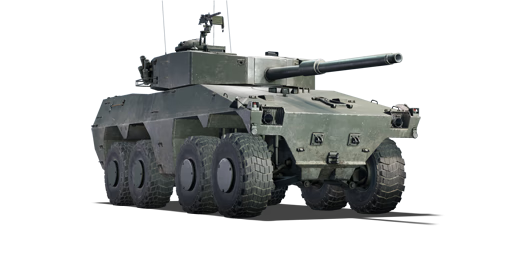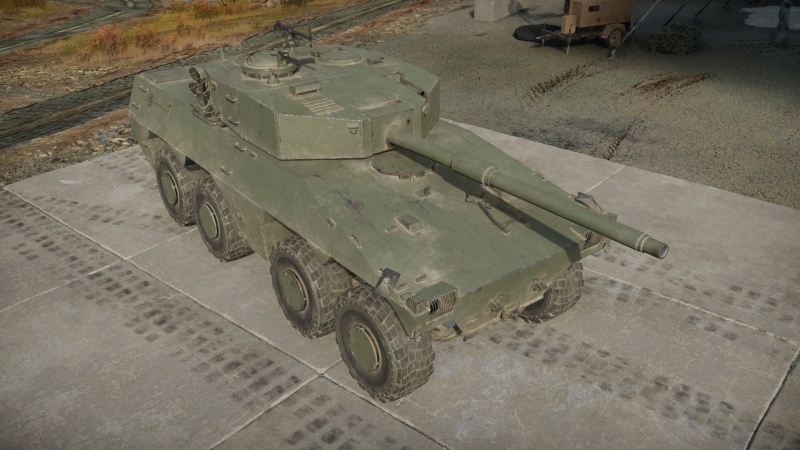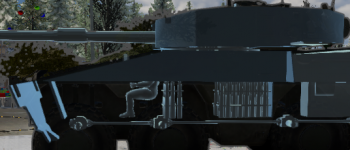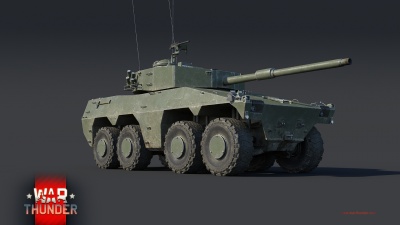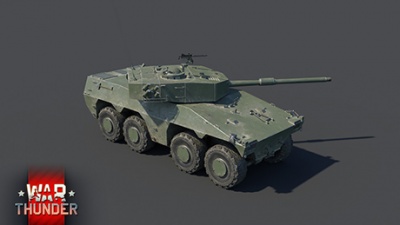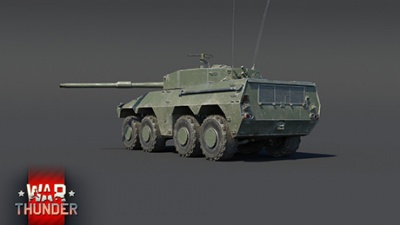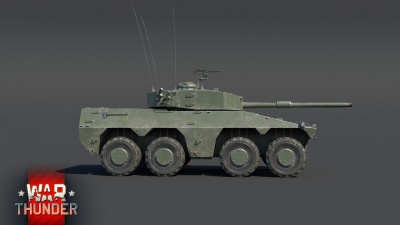Difference between revisions of "Class 3 (P)"
CobraKingII (talk | contribs) (→Media) (Tag: Visual edit) |
(→Survivability and armour) (Tag: Visual edit) |
||
| Line 11: | Line 11: | ||
=== Survivability and armour === | === Survivability and armour === | ||
{{Specs-Tank-Armour}} | {{Specs-Tank-Armour}} | ||
| − | <!-- ''Describe armour protection. Note the most well protected and key weak areas. Appreciate the layout of modules as well as the number and location of crew members. Is the level of armour protection sufficient, is the placement of modules helpful for survival in combat? If necessary use a visual template to indicate the most secure and weak zones of the armour.'' --> | + | <!-- ''Describe armour protection. Note the most well protected and key weak areas. Appreciate the layout of modules as well as the number and location of crew members. Is the level of armour protection sufficient, is the placement of modules helpful for survival in combat? If necessary use a visual template to indicate the most secure and weak zones of the armour.'' -->[[File:Class 3 inner spall shields.png|thumb|350x350px|As seen here, the frontal plate has double spall shields divided by a 200mm air spacing.]] |
| − | Due to the massive size of the Class 3, it is able to withstand high caliber ammunitions due to the poor armor as it will not create enough spalling when penetrating. The crew spacing as well as the interior spacing makes it one of the hardest wheeled vehicles to kill in the game with only kinetic energy (KE) penetrators (APDS, APDSFS, etc etc). Center of mass shots from the front with KE shells will often take the driver and the engine liting it on fire, but due to the turret crew being elevated, they are most likely to survive, meaning the turret is operational ready to engage any enemy threats. Chemical penetrators (CE) are a tricky topic when it comes to the frontal armor. Depending on the ammunition used an the impact angle, the Class 3 will be able to withstand the impact or not. CE rounds are most likely to penetrate and be partially or fully stopped thanks to the inner spall shields at an perpendicular angle but will kill driver and disable or damage engine as well as igniting the ammo rack. For this same reason it is recommended to only carry ~26 | + | [[File:Class 3 inner turrer spall shields.png|thumb|As seen here, the turret mantlet, front and sides all have double spall shields separated by an 80mm air spacing]] |
| + | Due to the massive size of the Class 3, it is able to withstand high caliber ammunitions due to the poor armor as it will not create enough spalling when penetrating. The crew spacing as well as the interior spacing makes it one of the hardest wheeled vehicles to kill in the game with only kinetic energy (KE) penetrators (APDS, APDSFS, etc etc). Center of mass shots from the front with KE shells will often take the driver and the engine liting it on fire, but due to the turret crew being elevated, they are most likely to survive, meaning the turret is operational ready to engage any enemy threats. Chemical penetrators (CE) are a tricky topic when it comes to the frontal armor. Depending on the ammunition used an the impact angle, the Class 3 will be able to withstand the impact or not. CE rounds are most likely to penetrate and be partially or fully stopped thanks to the inner spall shields at an perpendicular angle but will kill driver and disable or damage engine as well as igniting the ammo rack, this changes when ATGM's take a play in engagements. They will often create much more spalling than tank fired HEAT rounds as the caliber is higher (meaning a greater explosive mass) and will hullbreak you if hit from the sides or if the ATGM spall goes all the way from the front to the back while penetrating the sides. For this same reason it is recommended to only carry ~24-26 rounds in the vehicle as it will empty most of the hull ammo racks but still keep the ready racks full in the turret. The armor is not to be relied on unless there are specific enemies (T-54's for example) as most of them will always penetrate your hull. The Class 3 is immune to autocannon fire from the front and hull upper half sides and turret sides due to the spaced armor. This is an advantage compared to the rest of wheeled light armored vehicles in which 20mm and 30mm autocannons often penetrate and kill crew and inner components. | ||
| + | |||
| + | Having spall shields bring multiple benefits agaisnt both CE and KE. | ||
| + | |||
| + | ''When KE:'' | ||
| + | |||
| + | The air gap between plates not only reduce and scatter the shrapnel in a flatter surface so that the penetrating remains are less but they also reduce the speed and penetration of small caliber fire (bellow 40mm), meaning they will not penetrate the second plate (bellow 30mm) or will reduce the ammount of shrapnel generated (above 30mm). They also prematurely detonate APCBC shells and reduce the shrapnel generated. Due to this, all APCBC and APHE fuzes will be activated which can be lethal in calibers higher than 76mm even with the spall shields depending on where the round hits at. | ||
| + | |||
| + | ''When CE:'' | ||
| + | |||
| + | All the vehicle is suceptible to hull break if hit in the correct ways, but often players will fire at center of mass in which hull break is almost nullified. When a round is fired at the center of mass frontally, the double plate armor will not only reduce the shrapnel but it is able to fully stop it, specially if said threat has a relative low explosive mass despite the armor penetration (PG-9 for example found on the [[BMP-1 (Family)|BMP-1]]). When fired at the turret it may vary as it totally depends on the firing angle. A perpendicular hit to the turret will be lethal but an angled hit will often deviate the shrapnel which may damage or destroy modules but will keep the vehicle operational. Due to its huge height, the enemies that fire at turret will have a more angled hit, meaning that most of the shrapnel will be launched towards the roof and not to the crew compartment, this can take one or two crew members depending on the hit. | ||
'''Armour type:''' <!-- The types of armour present on the vehicle and their general locations --> | '''Armour type:''' <!-- The types of armour present on the vehicle and their general locations --> | ||
<!-- Example: * Rolled homogeneous armour (Front, Side, Rear, Hull roof) | <!-- Example: * Rolled homogeneous armour (Front, Side, Rear, Hull roof) | ||
* Cast homogeneous armour (Turret, Transmission area) --> | * Cast homogeneous armour (Turret, Transmission area) --> | ||
| + | * Rolled Homogeneous Armor | ||
| + | * High Hardness Rolled Armor | ||
| + | '''''Super structure armor''''' | ||
{| class="wikitable" | {| class="wikitable" | ||
|- | |- | ||
| Line 32: | Line 46: | ||
|} | |} | ||
| − | '''Notes:''' <!-- Any additional notes which the user needs to be aware of --> | + | '''''Inner spall shields''''' |
| + | {| class="wikitable" | ||
| + | |- | ||
| + | ! Armour !! Front (Slope angle) !! Sides !! Rear | ||
| + | |- | ||
| + | | Hull || 200 mm air | ||
| + | 38 mm second lower frontal plate (20°) | ||
| + | | 10 mm air | ||
| + | 30 mm upper half plate | ||
| + | | 5 mm | ||
| + | |- | ||
| + | | Turret || 84 mm turret front first plate | ||
| + | 80 mm air 38 mm turret front second plate<br>80 mm ''Gun mantlet'' | ||
| + | | 30 mm turret side first plate | ||
| + | 120 mm air 16 mm turret side second plate | ||
| + | | N/A | ||
| + | |}'''Notes:''' <!-- Any additional notes which the user needs to be aware of --> | ||
<!-- Example: * Suspension wheels are 20 mm thick, tracks are 30 mm thick, and torsion bars are 60 mm thick. --> | <!-- Example: * Suspension wheels are 20 mm thick, tracks are 30 mm thick, and torsion bars are 60 mm thick. --> | ||
| + | * Suspension is 10 mm thick | ||
| + | * Wheels are 10 mm thick | ||
=== Mobility === | === Mobility === | ||
{{Specs-Tank-Mobility}} | {{Specs-Tank-Mobility}} | ||
<!-- ''Write about the mobility of the ground vehicle. Estimate the specific power and manoeuvrability, as well as the maximum speed forwards and backwards.'' --> | <!-- ''Write about the mobility of the ground vehicle. Estimate the specific power and manoeuvrability, as well as the maximum speed forwards and backwards.'' --> | ||
| − | + | Despite the tremendous size and mass, the Class 3 is almost as fast as the [[Radkampfwagen 90|Radkampfwagen]]. The 8 wheels give it an almost perfect cross-country capability with exception of mud, snow and deep sand. Acceleration wise, it takes time to make the Class 3 move if on a non urban enviorment or at an angle due to the mass. It has traction on the 8 wheels, meaning it is able to move even if only a pairs of wheels are touching the ground. As expected, due to the lenght, the turn radious is huge and it requires a big surface to be abe to make a 180° turn. Besides the lenght and height, the Class 3 is tremendously fast for a vehicle its size, specially if it is on urban enviorment. It is able to reach speeds of 80 km/h even on dirt. This not only makes the Class 3 a fearful tough to crack behemoth but also a flanking and "Hit N' Run" behemoth. Thanks to the stabilizer, the Class 3 is able to fire at enemy targets while on top speed, this requires practice but a handled commander will be able to achieve so. | |
{{tankMobility|abMinHp=1,116|rbMinHp=695}} | {{tankMobility|abMinHp=1,116|rbMinHp=695}} | ||
| Line 47: | Line 79: | ||
== Armaments == | == Armaments == | ||
{{Specs-Tank-Armaments}} | {{Specs-Tank-Armaments}} | ||
| + | The Class 3 has a GT-3 105mm rifled bore main gun, it shares the same ballistics as the L7A3 the [[Leopard 1 (Family)|Leopard]] family share with the exact same ammunition. Thus, there should be no hard enough threat to kill, specially if DM33 is being used with its potent 408mm of penetration. | ||
| + | |||
=== Main armament === | === Main armament === | ||
{{Specs-Tank-Weapon|1}} | {{Specs-Tank-Weapon|1}} | ||
Revision as of 23:01, 6 January 2021
Contents
Description
The TH800 is a gift rank VI German tank destroyer with a battle rating of 9.0 (AB/RB/SB). It was introduced during Update "Hot Tracks" as a reward for the 2020 Operation W.I.N.T.E.R. event.
General info
Survivability and armour
Due to the massive size of the Class 3, it is able to withstand high caliber ammunitions due to the poor armor as it will not create enough spalling when penetrating. The crew spacing as well as the interior spacing makes it one of the hardest wheeled vehicles to kill in the game with only kinetic energy (KE) penetrators (APDS, APDSFS, etc etc). Center of mass shots from the front with KE shells will often take the driver and the engine liting it on fire, but due to the turret crew being elevated, they are most likely to survive, meaning the turret is operational ready to engage any enemy threats. Chemical penetrators (CE) are a tricky topic when it comes to the frontal armor. Depending on the ammunition used an the impact angle, the Class 3 will be able to withstand the impact or not. CE rounds are most likely to penetrate and be partially or fully stopped thanks to the inner spall shields at an perpendicular angle but will kill driver and disable or damage engine as well as igniting the ammo rack, this changes when ATGM's take a play in engagements. They will often create much more spalling than tank fired HEAT rounds as the caliber is higher (meaning a greater explosive mass) and will hullbreak you if hit from the sides or if the ATGM spall goes all the way from the front to the back while penetrating the sides. For this same reason it is recommended to only carry ~24-26 rounds in the vehicle as it will empty most of the hull ammo racks but still keep the ready racks full in the turret. The armor is not to be relied on unless there are specific enemies (T-54's for example) as most of them will always penetrate your hull. The Class 3 is immune to autocannon fire from the front and hull upper half sides and turret sides due to the spaced armor. This is an advantage compared to the rest of wheeled light armored vehicles in which 20mm and 30mm autocannons often penetrate and kill crew and inner components.
Having spall shields bring multiple benefits agaisnt both CE and KE.
When KE:
The air gap between plates not only reduce and scatter the shrapnel in a flatter surface so that the penetrating remains are less but they also reduce the speed and penetration of small caliber fire (bellow 40mm), meaning they will not penetrate the second plate (bellow 30mm) or will reduce the ammount of shrapnel generated (above 30mm). They also prematurely detonate APCBC shells and reduce the shrapnel generated. Due to this, all APCBC and APHE fuzes will be activated which can be lethal in calibers higher than 76mm even with the spall shields depending on where the round hits at.
When CE:
All the vehicle is suceptible to hull break if hit in the correct ways, but often players will fire at center of mass in which hull break is almost nullified. When a round is fired at the center of mass frontally, the double plate armor will not only reduce the shrapnel but it is able to fully stop it, specially if said threat has a relative low explosive mass despite the armor penetration (PG-9 for example found on the BMP-1). When fired at the turret it may vary as it totally depends on the firing angle. A perpendicular hit to the turret will be lethal but an angled hit will often deviate the shrapnel which may damage or destroy modules but will keep the vehicle operational. Due to its huge height, the enemies that fire at turret will have a more angled hit, meaning that most of the shrapnel will be launched towards the roof and not to the crew compartment, this can take one or two crew members depending on the hit.
Armour type:
- Rolled Homogeneous Armor
- High Hardness Rolled Armor
Super structure armor
| Armour | Front (Slope angle) | Sides | Rear | Roof |
|---|---|---|---|---|
| Hull | 30 mm glacis (76°)
29 mm lower frontal plate (20°) |
20 mm Top 20 mm Bottom |
20 mm | 10 mm |
| Turret | 38 mm Turret front 80 mm Gun mantlet |
16 mm | 20 mm | 10 mm |
| Cupola | 10 mm | 10 mm | 10 mm | 10 mm |
Inner spall shields
| Armour | Front (Slope angle) | Sides | Rear |
|---|---|---|---|
| Hull | 200 mm air
38 mm second lower frontal plate (20°) |
10 mm air
30 mm upper half plate |
5 mm |
| Turret | 84 mm turret front first plate
80 mm air 38 mm turret front second plate |
30 mm turret side first plate
120 mm air 16 mm turret side second plate |
N/A |
- Suspension is 10 mm thick
- Wheels are 10 mm thick
Mobility
Despite the tremendous size and mass, the Class 3 is almost as fast as the Radkampfwagen. The 8 wheels give it an almost perfect cross-country capability with exception of mud, snow and deep sand. Acceleration wise, it takes time to make the Class 3 move if on a non urban enviorment or at an angle due to the mass. It has traction on the 8 wheels, meaning it is able to move even if only a pairs of wheels are touching the ground. As expected, due to the lenght, the turn radious is huge and it requires a big surface to be abe to make a 180° turn. Besides the lenght and height, the Class 3 is tremendously fast for a vehicle its size, specially if it is on urban enviorment. It is able to reach speeds of 80 km/h even on dirt. This not only makes the Class 3 a fearful tough to crack behemoth but also a flanking and "Hit N' Run" behemoth. Thanks to the stabilizer, the Class 3 is able to fire at enemy targets while on top speed, this requires practice but a handled commander will be able to achieve so.
| Game Mode | Max Speed (km/h) | Weight (tons) | Engine power (horsepower) | Power-to-weight ratio (hp/ton) | |||
|---|---|---|---|---|---|---|---|
| Forward | Reverse | Stock | Upgraded | Stock | Upgraded | ||
| Arcade | 96 | 39 | 41 | 1,116 | 1,500 | 27.22 | 36.59 |
| Realistic | 86 | 35 | 695 | 786 | 16.95 | 19.17 | |
Modifications and economy
Armaments
The Class 3 has a GT-3 105mm rifled bore main gun, it shares the same ballistics as the L7A3 the Leopard family share with the exact same ammunition. Thus, there should be no hard enough threat to kill, specially if DM33 is being used with its potent 408mm of penetration.
Main armament
| 105 mm GT-3 | Turret rotation speed (°/s) | Reloading rate (seconds) | |||||||||||
|---|---|---|---|---|---|---|---|---|---|---|---|---|---|
| Mode | Capacity | Vertical | Horizontal | Stabilizer | Stock | Upgraded | Full | Expert | Aced | Stock | Full | Expert | Aced |
| Arcade | 54 | -8°/+15° | ±180° | Two-plane | __._ | __._ | __._ | __._ | __._ | _.__ | _.__ | _.__ | _.__ |
| Realistic | __._ | __._ | __._ | __._ | __._ | ||||||||
Ammunition
| Penetration statistics | |||||||
|---|---|---|---|---|---|---|---|
| Ammunition | Type of warhead |
Penetration @ 0° Angle of Attack (mm) | |||||
| 10 m | 100 m | 500 m | 1,000 m | 1,500 m | 2,000 m | ||
| DM12 | HEATFS | 400 | 400 | 400 | 400 | 400 | 400 |
| DM502 | HESH | 127 | 127 | 127 | 127 | 127 | 127 |
| DM23 | APFSDS | 337 | 335 | 330 | 322 | 314 | 306 |
| DM33 | APFSDS | 408 | 405 | 398 | 389 | 379 | 370 |
| Shell details | |||||||||
|---|---|---|---|---|---|---|---|---|---|
| Ammunition | Type of warhead |
Velocity (m/s) |
Projectile Mass (kg) |
Fuse delay (m) |
Fuse sensitivity (mm) |
Explosive Mass (TNT equivalent) (g) |
Ricochet | ||
| 0% | 50% | 100% | |||||||
| DM12 | HEATFS | 1,173 | 10.5 | 0.05 | 0.1 | 1,270 | 65° | 72° | 77° |
| DM502 | HESH | 732 | 14.85 | 0.05 | 0.1 | 4,310 | 73° | 77° | 80° |
| DM23 | APFSDS | 1,455 | 3.79 | N/A | N/A | N/A | 78° | 80° | 81° |
| DM33 | APFSDS | 1,455 | 3.79 | N/A | N/A | N/A | 78° | 80° | 81° |
Ammo racks
| Full ammo |
1st rack empty |
2nd rack empty |
3rd rack empty |
4th rack empty |
5th rack empty |
6th rack empty |
Visual discrepancy |
|---|---|---|---|---|---|---|---|
| 54 | __ (+__) | __ (+__) | __ (+__) | __ (+__) | __ (+__) | __ (+__) | __ |
Machine guns
| 7.62 mm Browning MG4 | ||||
|---|---|---|---|---|
| Mount | Capacity (Belt) | Fire rate | Vertical | Horizontal |
| Coaxial | 3,000 (250) | 500 | N/A | N/A |
| Pintle | 2,000 (250) | 500 | -8°/+20° | ±120° |
Usage in battles
Describe the tactics of playing in the vehicle, the features of using vehicles in the team and advice on tactics. Refrain from creating a "guide" - do not impose a single point of view but instead give the reader food for thought. Describe the most dangerous enemies and give recommendations on fighting them. If necessary, note the specifics of the game in different modes (AB, RB, SB).
Pros and cons
Pros:
- Fast
Cons:
- Prone to hull-breaking
- Huge size
History
Describe the history of the creation and combat usage of the vehicle in more detail than in the introduction. If the historical reference turns out to be too long, take it to a separate article, taking a link to the article about the vehicle and adding a block "/History" (example: https://wiki.warthunder.com/(Vehicle-name)/History) and add a link to it here using the main template. Be sure to reference text and sources by using <ref></ref>, as well as adding them at the end of the article with <references />. This section may also include the vehicle's dev blog entry (if applicable) and the in-game encyclopedia description (under === In-game description ===, also if applicable).
Devblog
Class 3 was the third and heaviest wheeled combat vehicle prototype to compete for the South African Army. When developing a heavy version of a wheeled tank, the designers were not limited by limits of weight or dimensions, therefore, in terms of weight, firepower and level of security, the Class 3 is a true wheeled tank. The competition commission opted for a lighter prototype, which later became the Rooikat 76 tank destroyer. The Class 3 prototype was exhibited at the Bloemfontein War Museum with a different turret.
Media
- Class 3 (P) Devblog Images
See also
External links
| Germany tank destroyers | |
|---|---|
| Pz. I Derivatives | Panzerjäger I |
| Pz. II Derivatives | 15cm sIG 33 B Sfl |
| Pz. 38(t) Derivatives | Marder III · Marder III H · Jagdpanzer 38(t) |
| Pz. III Derivatives | StuG III A · StuG III F · StuG III G · StuH 42 G |
| Pz. IV Derivatives | Jagdpanzer IV · Panzer IV/70(A) · Panzer IV/70(V) · Dicker Max · Nashorn · Brummbär · VFW |
| Pz. V Derivatives | Jagdpanther G1 · Bfw. Jagdpanther G1 |
| Pz. VI Derivatives | Sturer Emil · Elefant · Ferdinand · 38 cm Sturmmörser · Jagdtiger |
| Wheeled/Half-track | 8,8 cm Flak 37 Sfl. · Sd.Kfz.251/9 · Sd.Kfz.251/10 · Sd.Kfz.251/22 · Sd.Kfz.234/3 · Sd.Kfz.234/4 · 15 cm Pz.W.42 |
| ATGM Carrier | RakJPz 2 · RakJPz 2 (HOT) · Wiesel 1A2 |
| Other | Waffenträger · M109G · JPz 4-5 · Raketenautomat · VT1-2 |


